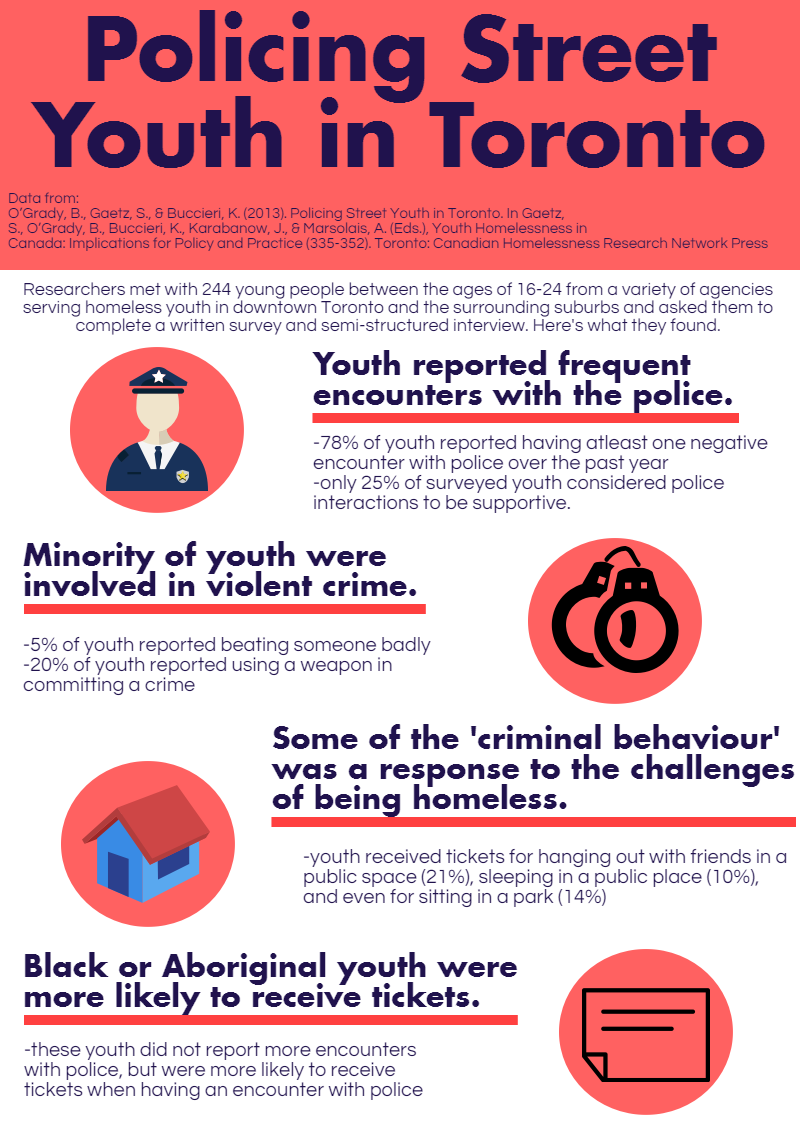This week’s infographic takes a look at the interaction of street youth in with the police in Toronto. Data in the infographic comes from a chapter in Youth Homelessness in Canada: Implications for Policy and Practice, a book that fills many gaps in the information available on youth homelessness. The book draws from homelessness research and focuses on effective solutions to youth homelessness. Like all Homeless Hub publications, it can be viewed, downloaded and shared for free.
Data in this infographic comes from a study conducted in partnership with Justice for Children and Youth in 2009. Justice for Children and Youth is a non-profit legal aid clinic that provides legal representation for low-income youth under the age of 18 and homeless youth who are under the age of 25. The organization has been around since the late 1970’s and will be celebrating its 40th anniversary in just three years.
The study sample was composed of 244 young people between the ages of 16-24 who were being served by organizations operating in the Greater Toronto Area. Youth were asked to complete a written survey and also participated in a semi-structured interview. Participants had to either be homeless or living without shelter for at least a week to be included in the sample.
Researchers found that 78% of youth reported having at least one negative encounter with police over the past year. Furthermore, only a quarter of youth considered police interactions to be supportive. Many of the ‘criminal behaviours’ that youth were ticketed or arrested for were responses to the many challenges associated with being homeless. Youth received tickets for hanging out with friends in a public space, sleeping in a public place and even for sitting in a park. The study also found that Black or Aboriginal youth were more likely to receive tickets. These youth did not report more encounters with police, but were more likely to receive tickets when they did have an encounter with police.
It is important to remind ourselves that ticketing youth for these actions amounts to penalizing them for being homeless. Youth, who may be ticketed for earning money through panhandling or squeegeeing, a lot of the time are unable to pay the fines they are charged with. Continued ticketing can result in accumulation of large debts, which prevents youth from moving forward with their lives. The presence of such punitive practices may actually heighten existing tensions between youth experiencing homelessness and law enforcement. Rather than solving homelessness itself, criminalization wrongly targets individuals who are living in homelessness.
Research that has been conducted into police practices with street youth in the Greater Toronto area doesn’t provide a very sunny picture of the status quo. However, this research does provide us with a street youth perspective on the relationship that exists between themselves and law enforcement. Awareness of the issue, by sharing infographics like this one, can play a role in improving police interactions with the homeless population.


